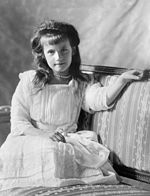Sophie Karlowna from Buxhoeveden
Sophie Karlovna of Buxhoeveden ( Russian :. София Карловна бар Букcгевден * 9. June 1883 in Saint Petersburg ; † 26. November 1956 in London ) was the last maid of honor at the court of Tsar Nicholas II. She followed the royal couple in the Siberian exile and after her survival wrote some works about the court of the tsars .
Life
Sophie Karlowna came into contact with social life in Saint Petersburg during her youth. In 1904 she entered the service of Tsarina Alexandra Feodorovna as a maid . In 1913 she was chosen to be the official lady-in-waiting of her Imperial Majesty . She named the four daughters of the tsarist family "Isa". The empress and her daughters had a very personal relationship with their lady-in-waiting. Sophie traveled several times with the tsarina and her daughters to see her German relatives and a relationship of trust developed between the two women.
When the royal family was captured in Saint Petersburg after the October Revolution and then deported to Siberia, Sophie was present as a lady-in-waiting. She survived the murder of the Tsar and his family. Other loyal followers of the Tsar included his personal physician Yevgeny Sergejewitsch Botkin and his chamberlain Paul Benckendorff . When Sophie reached Omsk after her escape , which was under the control of the Russian White Army and under the protection of the British military, she was able to leave Russia. The Baroness von Buxhoeveden was later accused of betraying the royal family and enriching herself personally through bribes. Her further “journey home” took her through China to Vladivostok , then to Japan via Hawaii to San Francisco . Her first long stay was with her father in Copenhagen , who lived there in exile . Her father arranged a move to London through the former German imperial family and Prince Heinrich of Prussia , who was related to both England and Russia . Despite some honors and expressions of confidence on the part of the English royal family, there was always a small doubt about the alleged loyalty to the Tsar.
The false daughter of the tsar
Sophie Karlowna was supposed to play an important role in the so-called Anna Anderson affair, it was about the identification of the alleged Tsar's daughter Anastasia . A confused woman who appeared in Berlin in 1920 claimed to be the Grand Duchess Anastasia and to have survived the Yekaterinburg massacre . Her mental confusion led to her being admitted to a mental hospital in Dalldorf . After the news about her stay in hospital became known, Baroness Sophie went to the alleged daughter of the Tsar. When the patient refused to speak and hid under a blanket, the baroness pulled the blanket off her and left the room. When leaving the room, the baroness said: "She is too small to be Anastasia." The Anna Anderson affair then continued with mutual accusations and suspicions and finally ended in that Anna Anderson should have been a con man. The myth of Anastasia was only ended 90 years after the murder of the tsarist family by means of DNA analysis .
Works
- 1928 The life and tragedy of Alexandra Feodorovna
- 1929 Left behind: Fourteen months in Siberia during the revolution, December 1917 - February 1919
- 1938 Before the Storm
Origin and family
Sophie Karlowna von Buxhoevede came from the German-Baltic noble family Buxhoeveden (House VI. Magnusdahl). Her father, Karlos Matthias Ludwig von Buxhoeveden (* 1856, † 1935 in Brussels) was a diplomat and a Russian minister with special tasks in Copenhagen during the First World War . He was married to Ludmilla Ossokin (1858-1917). Sophie Karlowna did not get married.
Web links
- Find a grave: Sophie Karlovna Buxhoeveden (English)
- Nicolai von Essen, Genealogical Manual of the Oesel Knighthood, page 79
- Sophie (Isa) from Buxhoeveden. Entry on Buxhoeveden.net
Individual evidence
- ↑ Elisabeth Heresch , Nikolaus II. “Cowardice, Lies and Treason” , FA Herbig Verlagbuchhandlung, Munich, 1992, pages 315 u. 336
- ^ "Anastasia" 1896 - 1984 / biography . Dieter Wunderlich: Book and film tips [1]
- ^ Robert K. Massie , The Romanovs. The last chapter , Deutsche Verlagsanstalt, Munich, 1995, ISBN 3-426-60752-2 , page 196
- ↑ Doris Heimann: "Dead Tsar children identified." In: Rheinische Post of July 17, 2008.
- ^ The life and tragedy of Alexandra Feodorovna. In: Internet archive [2]
- ^ Ludmilla von Buxhoeveden (Ossokin) in buxhoeveden.net
| personal data | |
|---|---|
| SURNAME | Buxhoeveden, Sophie Karlowna from |
| BRIEF DESCRIPTION | last lady-in-waiting of Tsarina Alexandra Feodorovna |
| DATE OF BIRTH | June 9, 1883 |
| PLACE OF BIRTH | St. Petersburg |
| DATE OF DEATH | November 26, 1956 |
| Place of death | London |


